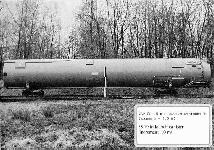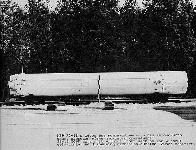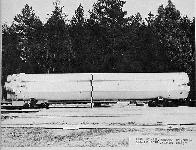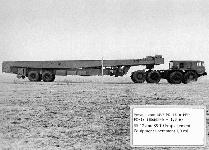





Once regarded by some as the "backbone" of the Soviet ICBM force, the fourth generation UR-100N / SS-19 intercontinental ballistic missile is a two-stage, tandem, storable liquid-propellant missile. The SS-19 is approxiamately 80 feet long and 8 1/2 feet in diameter. It was a competing design with the SS-17 Spanker, though in fact both were deployed to partially replace the SS-11 force.
The UR-100N is similar to the UR-100, but with an increased diameter and longer propellant tanks its launch weight was more than doubled and the throw-weight was increased over three-fold. The UR-100N uses asymmetrical dimethylhidrazine and nitrogen tetraoxide propellants. The first stage consists of four autonomous closed-cycle single-chambered rocket motors. The second stage has a closed-cycle single chambered sustainer and a four chambered open cycle control motor with four rotating nozzles. The guidance and control system of the SS-19 is identical to that of the SS-18, and permits remote monitoring of missile status while on alert, as well as automatic pre-launch preparation, remote missile targeting before launch and in-flight control of the missile via a flexible pitch control program. The UR-100N silos were constructed at the same sites as the UR-100U silos but were completely dismantled and rebuilt to increase the survivability of the new missiles. The UR-100N was launched in the hot mode through the thrust of the first stage sustainer engine.
The SS-19 has been deployed in three configurations.
When the START-1 treaty was signed in 1991 the Soviet Union had a total of 300 UR-100NUTTH missile stationed in Russia and Ukraine. After the dissolution of the Soviet Union Ukraine claimed ownersip of the missiles located on its territory. In compliance with the START treaty provisions Ukraine is in charge of the dismantling the launchers for the SS-19 missiles. However, all nuclear warheads that were deployed in Ukraine were dismantled by Russia.
Some 170 launchers remain in Russian territory, of which 10 were deactivated but not dismantled. In December 1995 Strategic Rocket Forces Commander Colonel General Igor Sergeyev announced a policy under which the service life of the SS-19 would be extended from 10 years to 25 years. The missiles will remain on alert at least through 2005, and the missiles that were deployed in the early 1980s will serve beoynd this.
Following the ratification of the START-II treaty by the Duma, Russia is obliged to dismantle all ground-based ICBMs with multiple warheads. Under the treaty provisions a total of 105 of the UR-100NUTTH missiles can be retained provided they are downloaded to carry only one warhead instead of six.
Specifications | ||||||
|
Mod-1 |
Mod-2 |
Mod-3 |
||||
|
DIA |
SS-19 |
SS-19 |
SS-19 |
|||
|
NATO |
Stiletto |
Stiletto |
Stiletto |
|||
|
Bilateral |
RS-18A |
RS-18A UTTKh |
RS-18B |
|||
|
Service |
UR-100N |
UR-100N |
UR-100NU |
|||
|
OKB/Industry |
15A30 |
15A30 |
15A35 |
|||
|
Design Bureau |
OKB-52, KB Salyut, Acad. V. N. Chelomey |
OKB-52, KB Salyut, Acad. V. N. Chelomey |
OKB-52, KB Salyut, Acad. V. N. Chelomey |
|||
|
Approved |
8/19/1970 |
8/19/1970 |
8/16/1976 |
|||
|
Years of R&D |
1964-73 |
1964-1973 |
||||
|
Engineering and Testing |
1973-75 |
1973-75 |
1977-79 |
|||
|
First Flight Test |
9/15/1972 failure & 12/28/1973 success |
4/9/1973 |
10/26/1977 |
|||
|
IOC |
4/26/1975 |
1975 |
1979 |
|||
|
Deployment Date |
12/301975 |
12/30/1975 |
11/5/1979 |
|||
|
Type of Warhead |
MIRV |
Single |
MIRV |
|||
|
Warheads |
6 |
1 |
6 |
|||
|
Yield per Warhead (Mt) |
0.5 0.55 0.750 |
2.5 - 5.0 |
0.5-0.75 |
|||
|
Payload (t) |
4.350 |
4.350 |
4.350 |
|||
|
Total length (m) |
24.0 |
24.0 |
24.3 |
|||
|
Total length w/o Warhead (m) |
21.1 |
21.1 |
21.1 |
|||
|
Missile Diameter (m) |
2.50 |
2.50 |
2.50 |
|||
|
Launch Weight (t) |
103 - 105.6 |
105.6 |
103.4 - 105.6 |
|||
|
Fuel Weight (t) |
93.1 |
93.1 |
93.1 |
|||
|
Range (km) |
9,650 |
10,000 |
10,000 |
|||
|
CEP (m) (Russian Sources) |
? |
? |
920 |
|||
|
CEP (m) (Western Sources) |
350-550 |
250-400 |
220-380 |
|||
|
Number of Stages |
2 |
|
Canister length (m) |
19.4 |
|
Canister length w/o front meters (m) |
|
|
Canister diameter (m) |
2.9 |
|
Booster guidance system |
Inertial |
|
1st stage |
2nd stage |
3rd. Stage |
|
|
Length (m) |
17.2 |
2.8 |
|
|
Body diameter (m) |
2.5 |
2.5 |
2.5 |
|
Fueled weight (t) |
86.3 |
86.3 |
|
|
Dry weight (t) |
|||
|
Engine Designation |
RD-0233 / RD-0234 |
RD-0235 (14/15D113) |
N/A |
|
Vernier Engine Designation |
N/A |
RD-0236 (15D114) |
N/A |
|
Bus Engine Designation Third Stage |
N/A |
N/A |
RD-0237 |
|
Design Bureau Main Engines |
OKB-154, Acad. S. A. Kosberg |
OKB-154, Acad. S. A. Kosberg |
N/A |
|
Design Bureau Vernier Engine |
N/A |
OKB-154, Acad. S. A. Kosberg |
N/A |
|
Design Bureau Bus Engine Third Stage |
N/A |
N/A |
OKB-154, Acad. S. A. Kosberg |
|
Configuration |
Cluster of four engines |
One engine |
N/A |
|
Configuration Vernier Engine |
N/A |
Four vernier chambers |
N/A |
|
Configuration Bus engine Third Stage |
N/A |
N/A |
Four chambers |
|
Years of R & D |
1969 1974 |
1969 - 1974 |
N/A |
|
Years of R & D Vernier Engine |
N/A |
1969 - 1974 |
N/A |
|
Years of R & D Bus Engine Third Stage |
N/A |
N/A |
1969 - 1974 |
|
Propellants |
Liquid |
Liquid |
Liquid |
|
Fuel |
UHMH |
UDMH |
UDMH |
|
Oxidizer |
Nitrogen Tetroxide |
Nitrogen Tetroxide |
Nitrogen Tetroxide |
|
Burning time (sec.) |
|||
|
Main Engine Thrust Sea Level/Vacuum (Tonnes) |
46.961/52.958 - 53.1 |
24.5 Vacuum |
N/A |
|
Verniers Thrust Sea Level/Vacuum (Tonnes) |
N/A |
1.6 Vacuum |
N/A |
|
Third Stage Bus Engine Thrust Vacuum (Tonnes) |
N/A |
N/A |
0.5 Vacuum |
|
Total Thrust Sea Level/Vacuum (Tonnes) |
187.8442/207.8319 |
30.9 Vacuum |
2.0 Vacuum |
|
Main Engine Specific Impulse Sea Level/ Vacuum (sec.) |
291 / 310 |
320 Vacuum |
N/A |
|
Vernier Engine Specific Impulse Sea Level/Vacuum (sec.) |
N/A |
293 Vacuum |
N/A |
|
Bus Third Stage Engine Specific Impulse Vacuum (sec.) |
N/A |
N/A |
? |
|
Basing Mode |
Silo |
|
Hardness |
|
|
Launching Technique |
Hot |
|
Deployed boosters |
|
|
Test Boosters |
|
|
Warheads Deployed |
|
|
Training Launchers |
|
|
Space Booster Variant |
Yes SL-X- ? , Rockot |
Deployment Sites
|
START |
Locale US-Designation |
|
Khmel ?Nitskiy |
Derazhnaya |
|
Kozel ?sk |
Kozelsk |
|
Pervomaysk |
Permovaysk |
|
Tatishchevo |
Tatishchevo |
 SS-19/RS-18 in Launch Canister |
 SS-19/RS-18 Missile |
 SS-19/RS-18 Stage 1 |
 |
